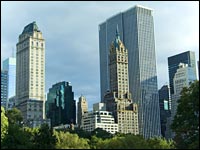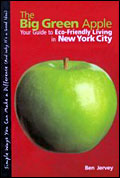Lately, green is the new black in the American metropolis. Here in New York City, the cabbies are driving hybrids and the fashionistas are wearing organic jeans. Even in my decidedly un-hip Brooklyn neighborhood, the corner deli sells organic milk and cookies.

Green is busting out all over.
Photo: iStockphoto.
Green-tinted consumerism is probably gaining ground in your city too. (Is that a Whole Foods opening up downtown? A Chipotle restaurant selling free-range pork burritos in the storefront that once nurtured a Krispy Kreme?) But if your city is anything like mine, centuries of energy, habitation, waste, and other systems are layered one on top of the other until they seem impervious to environmentally friendly living. And nature — that thing we’re trying to preserve when we buy post-consumer-content toilet paper — can seem set apart from daily life, even in a city blessed with the best of parks.
Urbanites game to reconnect with life cycles beyond the local latte joint may find Cosmo Doogood’s Urban Almanac 2006 a useful guide. Dedicated to “celebrating nature and her rhythms in the city,” it’s a riff on the traditional Old Farmer’s Almanac, aimed squarely at city slickers.
Doogood — an ebullient guise assumed by Eric Utne, founder of Utne magazine — provides the details on natural phenomena that tend to go right by harried urbanites: weather predictions, sun and moon rise, and various celestial events. Quotes, proverbs, historical dates, nature notes, and other nuggets of inspiration are sprinkled throughout, all generally short enough to be taken in while conserving that most precious urban resource: time. There’s even the odd hands-on project — decorating your own candles, or making yogurt cheese — to break the consumer trance of buying everything ready-made. (These may appeal to the Make magazine generation and their boomer parents, but will no doubt send a shiver down the spines of my own generational cohorts, who gladly left behind the candle-making with our 1970s childhoods.)
This eclectic content is arranged in a broadly drawn, politically progressive context, which includes brief biographies of against-the-grain activists deemed “Urban Treasures” and a longish essay on the political philosophies of that bastion of American iconoclasm, Benjamin Franklin.
The book is adorable verging on insufferable in its pseudo-rusticity. But when you find yourself ready to look between tall buildings to figure out the current phase of the moon, it will tell you what you need to know. It also steadfastly reworks the classic American equation of wilderness as saintly and urban as impure by offering up unlikely appreciations of the wild within the city — celebrating adaptable urban wildlife like raccoons, or looking for signs of the first frost on the surfaces of cars.

The Big Green Apple:
Your Guide to Eco-Friendly
Living in New York City,
by Ben Jervey,
Globe Pequot Press,
224 pgs, 2005.
By contrast, Ben Jervey’s The Big Green Apple: Your Guide to Eco-Friendly Living in New York City is a more utilitarian handbook. Jervey drills down within broadly defined sectors — household habits, energy consumption, transportation, food, work, and play — to offer advice on consumer choices that intersect with large-scale environmental problems, like dirty energy generation or factory farming.
Happily, Jervey goes beyond mere shopping tips, packing Apple with divergent info — from a breakdown of the city’s recycling rules to a recipe for nontoxic toilet-bowl cleaner — that helps make it a go-to green-living guide for New Yorkers. And several profiles of inspirational local projects are likely to surprise people who think there’s nothing ecological going on in Gotham — like the trailblazing Brooklyn Brewery, the first commercial building in New York City to source its entire electrical load from clean energy. (There’s something echt New York about a company that finds a way to parlay borough-boosting ales into up-to-the-minute ecological virtue.)
Nature figures most directly in Big Green Apple‘s picture as a recreational and restorative resource — one that city dwellers may appreciate more with the naturalist eye they’ll cultivate by checking in daily with Cosmo Doogood’s almanac. But the guide’s bigger context is restoration of the natural systems that support city life — the ultimate reason to eschew cars in favor of bicycles or other modes, and use compact fluorescent bulbs instead of energy-hogging incandescents.
The proliferation of hip, appealing eco-friendly goods on the shelves of city stores is a welcome development. So is the boom in ways to live lighter on the concrete. A guide to tapping into these trends can help newly inspired urbanites and eco-devotees alike refine their shade of green. But it’s handy to have even a reconstructed hayseed like Cosmo Doogood jar our gaze upward, from the plate-glass windows to the bigger picture. When enough of us city slickers have curbed our emissions, perhaps we’ll once again be able to see the real stars from Broadway … and from the middle of your city, too.



